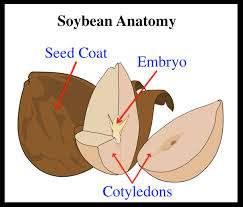As field activity ramps up for 2018, pay attention to soybean seed quality. Several factors soybeans experienced last fall resulted in delicate seed beans this spring that require careful handling during seed treatment and movement between bins, boxes, tanks, hoppers and the seedbed. Unseasonably warm temperatures during ripening dried soybeans too quickly. That was followed by repeated wetting and drying periods that delayed harvest and impacted development of the seed coat and its hardness. As a result, soybean seed germination may be reduced along with soybean seed coat intactness.
Soybean seed coat (an important component for holding the seed together) contains two cotyledon seed leaves that connect at the embryo. The seed takes up water, starting the germination process. Damage to the seed coat could lead to failure in germination and a reduction in stand establishment. Damage to the coat can also reduce seed integrity and viability, so handle with care.
 With a thin seed coat, pay special attention to how the seed is handled and moved. Slow auger and belt speeds and reduce the number of times the soybeans are handled and the distance the soybeans drop or fall. Move bags and boxes carefully to avoid damage while in transport. Any additional stress to the seed coat could cause it to crack and be completely displaced, leaving the soybean “naked” and allowing it to split into pieces.
With a thin seed coat, pay special attention to how the seed is handled and moved. Slow auger and belt speeds and reduce the number of times the soybeans are handled and the distance the soybeans drop or fall. Move bags and boxes carefully to avoid damage while in transport. Any additional stress to the seed coat could cause it to crack and be completely displaced, leaving the soybean “naked” and allowing it to split into pieces.
With known germination issues in the 2018 soybean seed supply, some seed lots may be labelled lower than 90 percent. Reference soybean seed tags before planting and account for any decrease in germination in order to calculate accurate planting rates.
To assure the best possible stand with these seed quality conditions, avoid as many negative environmental aspects as possible at planting time.
Consider planting conditions including soil temperature and moisture, and impending weather. Try to plant into warm, moist and crumbly soils so soybeans germinate quickly, rather than laying in dry soils or sitting setting in cold wet conditions. Make sure planting equipment is calibrated for precise seed placement and population settings in order to maximize seed count.
Despite seed germination and seed coat issues this season, growers should continue utilizing fungicide and insecticide seed treatment to provide protection from early seedling diseases and insects. Handle treated seed with care to avoid any further mechanical damage before planting.




 and then
and then